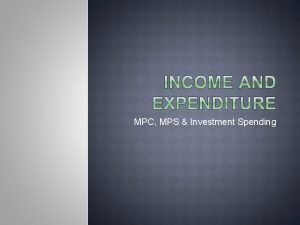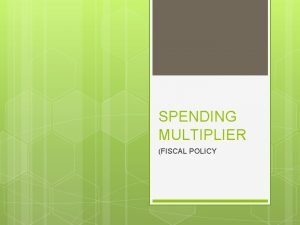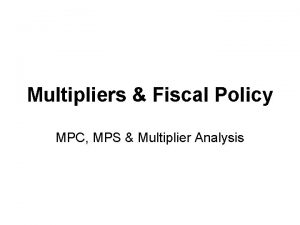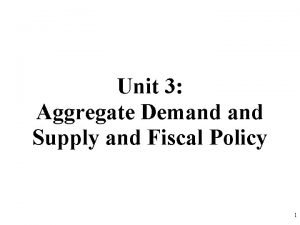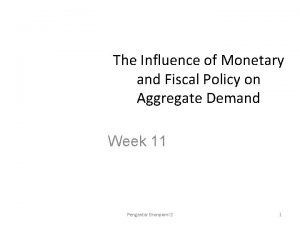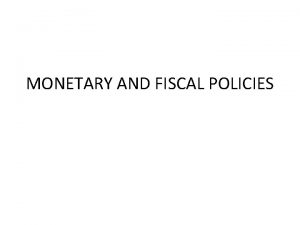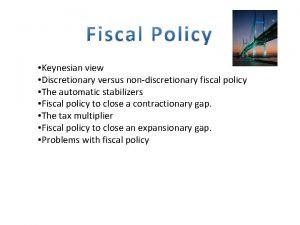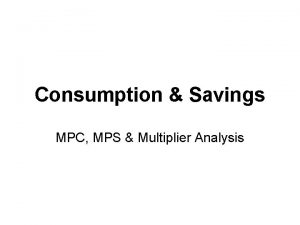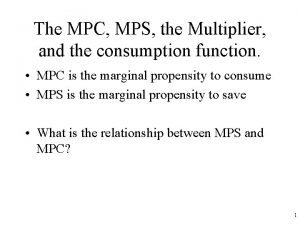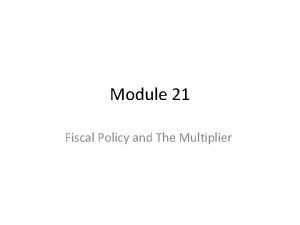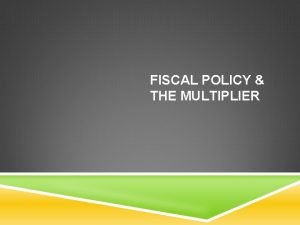Multipliers Fiscal Policy MPC MPS Multiplier Analysis 3












- Slides: 12

Multipliers & Fiscal Policy MPC, MPS & Multiplier Analysis

3 Types of Taxes • Progressive– Tax rate increase as income increases (tax brackets) – Example: Federal & California Income taxes • Regressive– Consumes a larger % of a low income worker’s salary – Example: Gasoline Tax, Bridge Tax • Flat – Same % for everyone – Example: Sales Tax, Some State income taxes

2019 Federal Tax Brackets

Multipliers & Fiscal Policy • Fiscal Policy has a multiplier affect on AD – If G↑ 1 billion => Real GDP ↑ by more than 1 billion! • Size of MPC/MPS determines how far AD shifts – Larger MPC => bigger multiplier => larger shift in AD! • 3 Multipliers for Fiscal Policy: – Gov’t Spending/Investment Multiplier: 1/MPS – Tax Multiplier: –MPC/MPS • always 1 less than Gov’t multiplier – Balanced Budget Multiplier = 1 • always 1

Multipliers in Circular Flow • If Gov’t Spending ↑ $100 => R-GDP will ↑ by ____? • Fiscal Policy has a “multiple” affect on R-GDP Government raises spending $100 PRODUCT Market If MPC =. 80 FIRMS HOUSEHOLDS FACTOR Market Multiplier = 5 i. e. 1/MPS => 1/. 20 = 5 Change in R-GDP: Round 1 $100. 0 Round 2 $80. 0 Round 3 $64. 0 Round 4 $51. 2 Etc…. . So a $100 ↑ => causes Real GDP ↑ $500

Example: ↑ Gov’t Spending $1 billion • Gov’t Multiplier = 1/MPS Example: If MPC Example: If G =. 80 ↑ $1 billion Multiplier => MPS =. 20 1/. 20 = 5 $1 B G X 5 = +$5 billion R-GDP Y 2 -Y 1 = +$5 billion R-GDP

Worksheet #1

Example: Tax Cut of 1 billion • Tax Multiplier = -MPC/MPS – Is always 1 less than Gov’t multiplier • Example: $1 billion tax cut & MPC =. 80 Tax Multiplier => -. 80/. 20 = -4 -1 billion X -4 = +4 billion in R-GDP (Y 2 – Y 1)

Balanced Budget Multiplier • Always equal to 1 (regardless of size of MPC) • Example: Government ↑ Taxes & ↑ Spending Example: Spending Multiplier = 10 Tax Multiplier = -9 G ↑ +1 billion = > Real GDP ↑ +10 billion Tax ↑ 1 billion => Real GDP ↓ -9 billion ----------------------------Net Effect: Real GDP ↑ +1 billion by 1 billion Always a difference of 1

Multipliers & Fiscal Policy Worksheet

Worksheet #2

Tax Cuts & MPC Group 1: MPC =. 90 Group 2: MPC =. 60 If taxes ↓ $1 billion, which GROUP would shift AD more? AD ↑ more with higher MPC Because, in short run, C↑ more BUT, in LONG RUN Savings turns into Investment So I is more powerful than C Raises full potential => LRAS ↑
 Mpc mps 1
Mpc mps 1 Mpc mps
Mpc mps Mpc multiplier calculator
Mpc multiplier calculator Gov spending multiplier
Gov spending multiplier Fiscal policy to control inflation
Fiscal policy to control inflation Example fiscal policy
Example fiscal policy Tax multiplier formula
Tax multiplier formula Components of fiscal policy
Components of fiscal policy Crowding out effect of fiscal policy
Crowding out effect of fiscal policy Lesson 2 activity 45 macroeconomics
Lesson 2 activity 45 macroeconomics Instruments of fiscal policy
Instruments of fiscal policy Non discretionary fiscal policy
Non discretionary fiscal policy Instruments of fiscal policy
Instruments of fiscal policy

